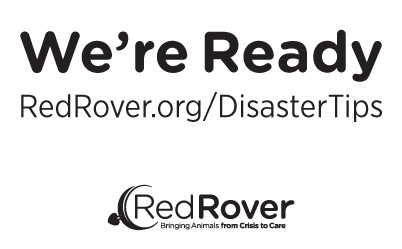Make sure your pets are protected when disaster strikes. Download our 5 Animal Disaster Preparedness Essentials checklist (PDF):
Get more details on emergency planning for specific types of disasters:
Planning ahead is the key to keeping yourself and your pets safe if disaster strikes. Follow these tips to make an emergency plan for your pets:
1. Microchip your pets
Microchip identification is one of the best ways to ensure that you and your pet are reunited if you are separated. Be sure to keep the microchip registration up-to-date, and include at least one emergency number of a friend or relative who resides out of your immediate area.
2. Keep a collar and tag on all cats and dogs
Keep several current phone numbers on your animal’s identification tag. Identification on indoor-only cats is especially important. If your home is damaged during a disaster, they could easily escape.
3. Plan a pet-friendly place to stay
Search in advance for out-of-area pet-friendly hotels or boarding facilities, or make a housing exchange agreement with an out-of-area friend or relative. Never leave your pet behind if you evacuate!
Search for pet-friendly accommodations at:
- Pet Friendly Hotels (United States)
- PetsWelcome.com (United States)
- DoginMySuitcase.com (International)
- PetTravel.com (International)
4. Use the buddy system
Exchange pet information, evacuation plans and house keys with a few trusted neighbors or nearby friends. If you’re caught outside evacuation lines when an evacuation order is issued, your neighbors or friends can evacuate your pets for you.
5. Prepare an emergency kit for each animal
Stock up on the items you may need during a disaster now so you do not get caught unprepared. Below are basic items you should include in your pets’ disaster kits. Store your disaster kit supplies in an easy-to-grab container.
- One-week supply of food. Store it in a water-tight container and rotate it every three months to keep it fresh. If you use canned food, include a spare can opener.
- One-week supply of fresh water. If officials declare your household water unfit to drink, it’s also unsafe for your pets. Follow American Red Cross guidelines for storing emergency water for your family and your pets.
- Medication. If your animal takes medication, a replacement supply may not be easily available following a disaster.
- Copies of vaccination records
- Photographs of you with your pets to prove ownership
- Photographs of your pets in case you need to make “lost pet” fliers
- Pet first aid kit
- Temporary ID tags. If you’ve evacuated, use this to record your temporary contact information and/or the phone number of an unaffected friend or relative.
- Carrier or leash for each animal. Caregivers of multiple cats or other small animals can use an EvacSak, which is easy to store and use for transport.
Get more details on emergency planning for specific species:
6. Identify emergency veterinary facilities outside of your immediate area
If a disaster has affected your community, emergency veterinary facilities may be closed. Pets may become injured or ill during the disaster, so make sure you know how to access other emergency facilities. You can also check with your veterinarian to find out if they have an emergency plan that includes setting up in an alternate, emergency facility.
7. Plan for temporary confinement
Physical structures, like walls, fences and barns may be destroyed during a disaster. Have a plan for keeping your animal safely confined. You may need a tie-out, crate or kennel.
Often, when animals are evacuated to unfamiliar locations, their stress and fear can lead to illness injury. Read more tips for ensuring your pets’ safety during an evacuation.
8. Comfort your animals
Your animals will appreciate your calm presence and soft, comforting voice if they are stressed following a disaster or while evacuated, and you may find it comforting to spend time with them, too. Some animals, especially cats, may be too scared to be comforted. Interact with them on their terms. Some animals may find toys, especially long-lasting chew toys, comforting.
9. Know where to search for lost animals
When animals become lost during a disaster, they often end up at a local shelter. Keep handy the locations and phone numbers of the shelters in your area.
10. Get children involved in disaster preparedness plans. The book Ready or Not, Here it Comes! by RedRover Responders Team Leader, Howard Edelstein, discusses how to prepare for all types of disasters to safeguard families and the animals in their care.
If a disaster hit your town, would you be prepared to care for your pet? Assemble your kit, then join our “We’re Ready” campaign:
Post the “We’re Ready” sign on your Facebook page to show everyone that you and your pet(s) are evacuation-ready.



Leave a Reply